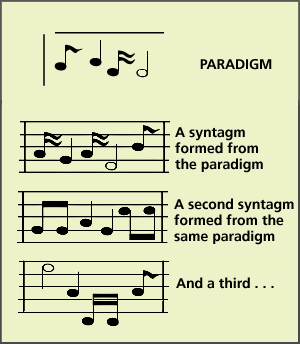
As an example, consider the notation that is used to write out the musical notes of a song. In this case the paradigm is a set of symbols: lines, bars, dots, notes, numbers and others. The example on this page shows a very simple "music" paradigm that consists of a long horizontal line, a shorter vertical line, and three different "note" symbols.

Although many different syntagms could be formed from this paradigm, only three are shown. Notice that the syntagms are not just randomly thrown together, but are constructed using certain rules. In this case the rules include such as:
The term "paradigm" refers to whatever set of signs is chosen as the basic set. Thus, a collection of syntagms formed from one paradigm may itself be chosen as a paradigm. This happens, for example, in English where the alphabet is the paradigm from which the syntagms of English words are formed, after which the set of English words becomes the paradigm from which English sentences are formed, and so on.